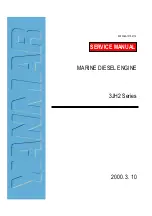
OPM 320 en-GB
34
©
Scania CV AB 2019, Sweden
Cooling system
Cooling system
Coolant
Note:
The coolant should be changed when the cooling
system is cleaned: every 6,000 hours or at least
every five years. See
.
The coolant recommended by Scania is a mix-
ture of water with antifreeze (ethylene glycol)
and corrosion inhibitor. The coolant has several
characteristics which are important for the oper-
ation of the cooling system:
• Corrosion protection.
• Antifreeze.
• Increases the boiling point.
Water
Use only pure fresh water that is free of particles,
sludge and other impurities. If there is uncertain-
ty about the quality of the water, Scania recom-
mends use of Scania ready-mixed coolants. See
the section
Antifreeze and corrosion protection
The antifreeze and corrosion protection used in
Scania engines should be antifreeze (ethylene
glycol) and corrosion inhibitor.
Only Scania coolant or another product with
functioning antifreeze and corrosion protection
may be used in Scania engines. Products not ful-
filling the demands in this section may lead to
faults and damage occurring in the cooling sys-
tem. This can lead to the invalidation of Scania's
warranty for faults and damage caused by the use
of inappropriate coolant.
Addition of antifreeze and corrosion
inhibitor to water
The coolant should contain 35-55% by volume
antifreeze (ethylene glycol) and corrosion inhib-
itor. The percentage varies depending on the
need for antifreeze.
A minimum of 35% by volume of Scania anti-
freeze and corrosion protection is needed to pro-
vide sufficient protection against corrosion.
Note:
Too high a dose of antifreeze and corrosion in-
hibitor will increase the amount of sludge and
blockages accumulating in the radiator. Too low
a concentration can lead to corrosion of the cool-
ing system and ice formation at low tempera-
tures.
Measure the ethylene glycol content (antifreeze
and corrosion protection) with a refractometer
following the instructions in the
coolant's antifreeze and corrosion protection
sec-
tion.
















































